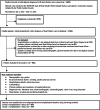Risk factors for prolonged hospitalization in acute decompensated heart failure from the HEROES study
- PMID: 40783608
- PMCID: PMC12335576
- DOI: 10.1038/s41598-025-14100-1
Risk factors for prolonged hospitalization in acute decompensated heart failure from the HEROES study
Abstract
This study, part of the HEROES project (HEart failure Risk factOrs and patiEnt Stratification), aimed to identify clinical, laboratory, functional, and treatment-related factors associated with hospitalization duration (above and below 8 days) in patients admitted for acute decompensated heart failure (ADHF). We analyzed 562 Caucasian patients hospitalized due to acute decompensated heart failure (ADHF), divided into two groups based on length of stay (LOS): ≤ 8 days (n = 287; 51.07%) and > 8 days (n = 275; 48.93%). In the ≤ 8 days group, 203 patients (70.73%) were male, while in the > 8 days group, 202 patients (73.45%) were male. Data on sociodemographic features, clinical characteristics, laboratory and imaging findings, treatment details, and patient-reported health status (KCCQ-12) were collected. Multivariate logistic regression identified independent predictors of prolonged hospitalization. Patients with longer LOS had higher NYHA class (p < 0.001), greater comorbidity burden (p = 0.0019), longer intensive cardiac care unit (ICCU) stay (p < 0.001), and higher in-hospital mortality (p = 0.0006). They also showed elevated NT-proBNP (p < 0.0001), procalcitonin (p = 0.03), and creatinine (p = 0.0002), and lower hemoglobin (p = 0.004), hematocrit (p = 0.014), and sodium (p = 0.0325). In the multivariate analysis, independent predictors of prolonged hospitalization included treatment with norepinephrine (OR = 18.41), dopamine (OR = 8.62), and oral iron therapy (OR = 3.25). Conversely, protective factors associated with a reduced risk of prolonged hospitalization were higher KCCQ-12 scores (OR = 0.98), higher systolic blood pressure at admission (OR = 0.99), and prior statin use (OR = 0.56). In the HEROES study, prolonged hospitalization among ADHF patients was associated with more severe symptoms of heart failure decompensation higher comorbidity load, impaired functional and laboratory parameters and need for longer stay in ICCU. Early identification of high-risk patients may facilitate personalized management and optimize healthcare resource utilization.
Keywords: Heart failure; Hospitalization; Length of stay; Prognostic indicators; Risk factors.
© 2025. The Author(s).
Conflict of interest statement
Declarations. Competing interests: The authors declare no competing interests. Software tools and image creation: All illustrations and figures were prepared by the authors using standard office software. Tables and Fig. 2 (chart) were created using Microsoft Excel, while Fig. 1 was created using Microsoft Word. Microsoft Word was also used for formatting and preparing the entire manuscript. Institutional review board statement: Data were collected using an electronic case report form (eCRF), in compliance with data protection regulations, including the GDPR. The study protocol was approved by the Bioethics Committee of the Medical University of Lodz (approval no. RNN/316/20/KE, with subsequent amendment KE/762/23), and the study was funded by the Polish Cardiac Society (contract no. CRU0120-KCKB-2023). Informed consent statement: Written informed consent was obtained from all participants.
Figures


Similar articles
-
Predicting 1-year heart failure hospitalization and mortality post-discharge from the intensive cardiac care unit.ESC Heart Fail. 2025 Aug;12(4):2450-2459. doi: 10.1002/ehf2.15140. Epub 2025 May 21. ESC Heart Fail. 2025. PMID: 40396440 Free PMC article.
-
Comparative performance of risk prediction indices for mortality or readmission following heart failure hospitalization.ESC Heart Fail. 2025 Apr;12(2):1227-1236. doi: 10.1002/ehf2.15129. Epub 2025 Jan 21. ESC Heart Fail. 2025. PMID: 39835342 Free PMC article.
-
Contemporary Profile and In-Hospital Outcomes of Decompensated Heart Failure in a Semi-Rural Setting in Cameroon: The Buea Heart Study.Glob Heart. 2025 Jun 23;20(1):56. doi: 10.5334/gh.1442. eCollection 2025. Glob Heart. 2025. PMID: 40585393 Free PMC article.
-
[Volume and health outcomes: evidence from systematic reviews and from evaluation of Italian hospital data].Epidemiol Prev. 2013 Mar-Jun;37(2-3 Suppl 2):1-100. Epidemiol Prev. 2013. PMID: 23851286 Italian.
-
Procalcitonin to initiate or discontinue antibiotics in acute respiratory tract infections.Evid Based Child Health. 2013 Jul;8(4):1297-371. doi: 10.1002/ebch.1927. Evid Based Child Health. 2013. PMID: 23877944
References
-
- McDonagh, T. A. et al. 2021 ESC Guidelines for the diagnosis and treatment of acute and chronic heart failure. Eur. Heart J.42(36), 3599–3726 (2021). - PubMed
-
- Tromp, J. et al. Age-related characteristics and outcomes of patients with heart failure with preserved ejection fraction. J. Am. Coll. Cardiol.74(5), 601–612 (2019). - PubMed
-
- McMurray, J. J. V. et al. Dapagliflozin in patients with heart failure and reduced ejection fraction. N. Engl. J. Med.381(21), 1995–2008 (2019). - PubMed
MeSH terms
Substances
LinkOut - more resources
Full Text Sources
Medical
Research Materials

